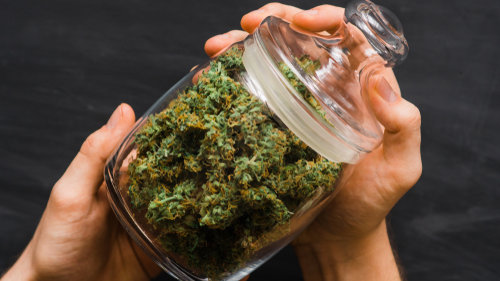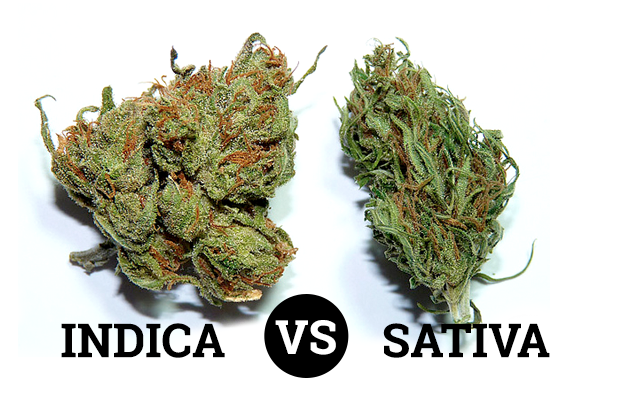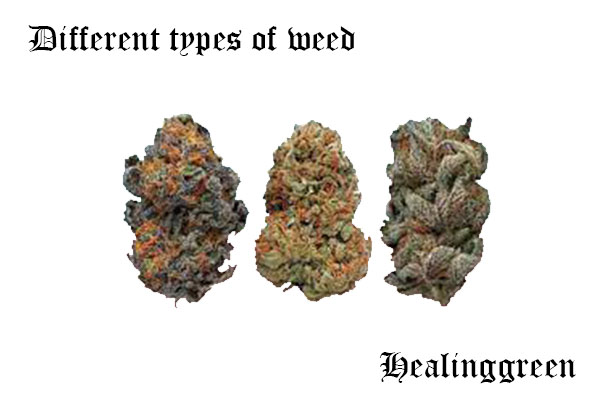Each cannabis strain has a different concentration of the cannabinoids tetrahydrocannabinol (THC), cannabidiol (CBD), as well as other compounds. Producers grow the plants to have a certain look, taste, and effect on the user and brand them accordingly. Currently, reports on the effects of different cannabis strains come predominantly from people’s experiences. Although researchers are studying the effects of a variety of cannabis strains on a range of medical conditions, there is still a long way to go in this area.
Keep reading to learn more about cannabis strains, and which are the most popular.
What is a marijuana strain?
If you’ve read a little about marijuana, or if you enter most dispensaries, you might see the words indica, sativa, and hybrid. Generally, most people divide marijuana into these three categories.
Indica, which originates from the Hindu Kush mountains of India, is believed to have a relaxing effect on the user. Sativa has a more energizing effect, while hybrid is a combination of the two.
Many industry experts, however, are reconsidering the indica, sativa and hybrid categories. According to Amos Elberg, head of data science at Confident Cannabis, these terms are more or less meaningless.
“We see samples of all cannabis products tested through our partner labs, and when we look at all the data, particularly of the chemical makeup of flower, we see no identifiable characteristics that are consistent with indica, sativa, or hybrid,” he explains.

“Essentially people are using these terms as catchalls for effect, but they’re not all consistent with those effects. Some indica makes some people wired, not couch-locked, for instance.”
In other words, people shouldn’t be alarmed if a reportedly energizing sativa strain has more of a mellowing effect, or if an indica strain makes them feel more bubbly and excitable.
Beyond indica, sativa, and hybrid, dispensaries might divide the types of cannabis they have into strains. Strains are essentially different breeds of cannabis, and they’re bred to have specific effects on the user.
But if the terms indica, sativa, and hybrid are essentially useless categorizations, are strain names also meaningless?
Not exactly, says Elberg.
“Not all seeds that are sold under the same name are genetically identical, or even necessarily related. Some producers may choose to create a strain name essentially as a branding exercise, or to identify their product with an existing name because they believe the product matches characteristics the market expects from product sold under that name,” Elberg explains.
There are, however, still consistencies among product sold under specific strain names, Elberg adds.
“In general, for the less common names, product sold by different vendors tends to be pretty consistent,” he notes. “For the most common strain names, however, a wider variety of different products are sold.”
If you purchase product from a quality source, the strains should be more or less consistent. Bear in mind, however, that every person reacts differently to cannabis.
Different types of strains
According to user reviews on Leafly, here’s what people might expect from a few of the most popular marijuana strains.
Acapulco Gold
Originating from Acapulco, Mexico, Acapulco Gold is a well-known and highly praised strain of cannabis. It’s noted for its euphoria-inducing, energizing effects. It’s said to reduce fatigue, stress, pain, and even nausea.
Blue Dream
Blue Dream is relaxing and soothing, but it isn’t a total sedative. This makes it perfect for easing pain, cramps, or inflammation for when you can’t afford to fall asleep. Plus, it’s said to lift your mood and give you a feeling of euphoria.
Purple Kush
Purple Kush is great for inducing a state of bliss so that you feel relaxed, happy, and sleepy. It’s often used for reducing pain and muscle spasms. Its sedating effects means it can be used to reduce insomnia.
Sour Diesel
A highly energizing, mood-lifting strain, Sour Diesel is great for giving you a burst of productive energy. It also has notable destressing and pain-relieving effects.
Bubba Kush
Bubba Kush is a relaxing, sleep-inducing strain. It’s perfect for helping you fight insomnia and get some shut-eye. It also offers pain-reducing, stress-relieving results.
Granddaddy Purple
Granddaddy Purple is another highly relaxing strain. It’s often praised for its insomnia-fighting and stress-reducing results. Users also note that it can make you feel euphoria and increase hunger, which is great if you’re experiencing a lack of appetite.
Afghan Kush
Originating from the Hindu Kush mountains near the Afghanistan-Pakistan border, Afghan Kush is super relaxing and sleep-inducing. This, too, can help you feel hungry if you’re experiencing a lack of appetite, and can relieve pain.
LA Confidential
LA Confidential is another relaxing and sleep-inducing strain that is often used to soothe insomnia. It’s also said to have noticeable anti-inflammatory and pain-reducing effects, which makes it a favorite among people with chronic pain.
Maui Wowie
Maui Wowie can help you feel super relaxed, yet energetic and creative. It reduces fatigue, too, making it great for days when you need to be productive.
Golden Goat
Golden Goat is notable for making users feel euphoric and creative. It’s also great for reducing fatigue and stress while lifting your mood.
Northern Lights
Northern Lights is another relaxing, sleep-inducing strain. It’s also known for its mood-lifting effects, and it can be used to relieve insomnia, pain, stress, and depression.
White Widow
White Widow improves your mood, gives you energy, and relaxes you all at once. It’s said to help reduce pain and stress, as well as feelings of depression. If you’re feeling fatigued, White Widow might help you stay energized and alert.
THC vs. CBD
So far, most researchTrusted Source into the medical benefits of cannabis has focused on THC and CBD.
However, researchers and scientists remain unsure of the ideal quantities of THC and CBD that people should use for various medical conditions or recreation.
Although both THC and CBD are cannabinoids, they act differently in the body because they target different areas in the brain.
According to a 2020 articleTrusted Source, people who use products with a higher THC content may experience psychoactive effects, such as euphoria and a greater sensitivity to things such as color and taste. However, THC also can lead to anxiety and paranoia.
CBD, on the other hand, is non-intoxicating. Some people report mild physiological effects, such as reduced anxiety when using CBD.
Animal studies suggest CBD may help improve vomiting, nausea, pain, and offer neuroprotective effects on the brain.
However, since CBD can affect mood, some expertsTrusted Source describe it as a non-intoxicating but psychoactive compound.
The Food and Drug Administration (FDA) have approvedTrusted Source some cannabis-related products including:
- two synthetic THC medications for the treatment of anorexia associated with AIDS
- another synthetic cannabis-related product for the treatment of nausea and vomiting associated with cancer treatment
- cannabis-derived CBD for children 2 years and older who suffer from rare seizure disorders
Studies Trusted Sourceare ongoing to determine whether CBD has other physiological effects. Preliminary human data suggests CBD could benefit conditions, such as schizophrenia and even opioid addictionTrusted Source.
Sativa vs. Indica
The terms indica and sativa derive from the biolgical classification of these species, which is based on physical characteristics. Cannabis indica plants are shorter and have broad, dark green leaves. Cannabis sativa plants grow taller and develop thinner, pale green leaves.
In the past, people used these terms to differentiate the cannabis plants in terms of their effects and THC or CBD content. An article in Cannabis and Cannabinoid ResearchTrusted Source seems to dispel these claims.
Previously, people believed that Cannabis indica plants contained higher levels of CBD. As a result, cultivators and dispensaries marketed indica-derived strains as a product that would lead to a more ‘relaxed high’.
Conversely, Cannabis sativa-derived strains that contained higher levels of THC would provide a more energetic high.
Many experts caution against this generalization, noting that even if this classification scheme were true, there is no way to be sure of the accuracy of any strain name.

There is no third-party agency that validates which strain names belong to indica, sativa, or hybrid.
To know exactly what is in a cannabis product, the manufacturers must analyze the product in a biochemical assay.
It is easy to see why this topic continues to cause debate. Cannabis is a complex plant, and, as of right now, there seems no obvious or simple way to categorize the various strains by ‘effect on the user.’
Each person who tries a strain of cannabis may have a different experience.
For example, some people describe the effects of Cannabis indica-derived products as sedating. However, other components of cannabis can also cause sedation, as well as other psychoactive effects. Compounds include:
- linalool
- myrcene
- limonene
- alpha-pinene
These components are often absent in a description of a cannabis-derived product, which is why some experts suggest that manufacturers should abandon naming their products as sativa or indica. Using these names is misleading and far more complex than people once thought.

Sour Diesel is a perfect balance of euphoric and calming effects. It’s also arousing, making it highly recommended for people who want to be social but don’t often get the chance!